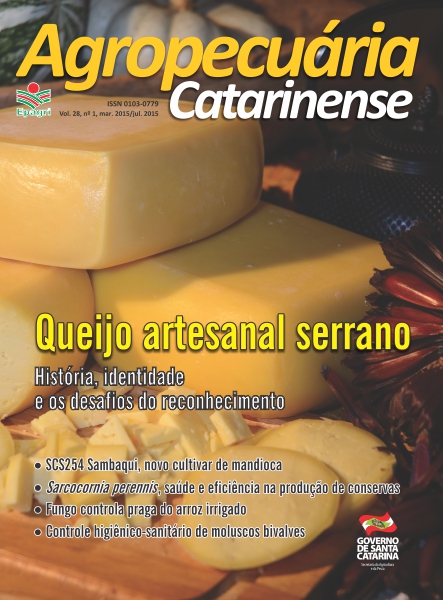Processing of canned Sarcocornia perennis
DOI:
https://doi.org/10.52945/rac.v28i1.188Keywords:
acidic canned product, Phaseolus vulgaris, acceptance.Abstract
The aim of this work was to produce and to evaluate the acceptance of Sarcocornia perennis conserves. Due to little availability of samples of Sarcocornia perennis in the Germplasm Bank of Epagri/EEI, an initial study was carried with Phaseolus vulgaris (string bean) using a factorial 2³. Analysis of pH, °Brix, titratabel total acidity and preference tests had been carried out, where four formulations with balanced concentrations on higher sugar content had been selected. Another preference test was carried out for the conserve of S. perennis, where the formulation sample of the factorial planning central point was selected, whose concentrations of vinegar, salt and sugar were intermediate. The data indicated that the conserve of S. perennis can be a potential product to encourage production by family farmers, due to the degree of acceptance and to the 59% yield. In view of commercial growing occurrence in some countries, with high value added for the commercialized canned products, this crop may be recommended as a market product.Metrics
Publication Facts
Reviewer profiles N/A
Author statements
- Academic society
- Epagri - Revista Agropecuária Catarinense
- Publisher
- Empresa de Pesquisa Agropecuária e Extensão Rural de Santa Catarina - Epagri
References
ALONSO, M.A.; CRESPO, M.B. Taxonomic and nomenclatural notes on South American taxa of Sarcocornia A. J. Scott (Chenopodiaceae). Ann. Bot. Fennici., v.45, p.241-254, 2008.
BELLEGARD, C.R.G.; RAUPP, D.S.; CHAIMSOHN, F.P. et al. Avaliação de procedimentos de acidificação de conservas de palmito foliar de pupunha (Bactris gasipaes). Acta Scientiarum: Agronomy, Maringá, v.27, n.2, p.247-254, 2005.
BENEVIDES, C.M.J.; FURTUNATO, D.M.N. Hortaliças acidificadas. Ciência e Tecnologia de Alimentos, Campinas, v.18, n.3, p.271-274, 1998.
BERTIN, R. L.; GONZAGA, L.V.; BORGES, G. S. C. et al. Nutrient composition and, identification/quantification of major phenolic compounds in Sarcocornia ambígua (Amaranthaceae) using HPLC-ESI-MS/MS. Food Research International, v.55, p.404-411, 2014.
BRASIL. Comissão Nacional de Normas e Padrões para Alimentos. Resolução nº 13, de maio de 1977. Estabelece características mínimas de identidade e qualidade para as hortaliças em conserva. Diário Oficial [da] República Federativa do Brasil, Poder Executivo, Brasília, DF, seção 1.
CAMARGO, G.A.; HAJ-ISA, N.; QUEIROZ, M.R. Avaliação da qualidade de tomate seco em conserva. Revista Brasileira de Engenharia Agrícola e Ambiental, v.11, n.5, p.521-526, 2007.
FARIA, E.V. de; YOTSUYANAGI, K. Técnicas de análise sensorial. 2.ed. Campinas: ITAL, 2008. 116p.
FLOWERS, T.J.; COLMER, T.D. Salinity tolerance in halophytes. New Phytologist. Lancaster, v.179, p.945-963, 2008.
INSTITUTO ADOLFO LUTZ. Manual IAL. São Paulo, 2007. 73p.
KROLOW, A.C.R. Agroindústria familiar: hortaliças em conserva. Brasília: Embrapa Informação Tecnológica, 2006. 40p.
LEE, W.M.; SUNG, H.J.; JONG, C. et al. Effects of solvent-extracted fractions from Salicornia herbacea on anti-oxidative activity and lipopolysaccharide-induced no production in murine macrophage RAW264.7 cells. Journal of Experimental Biomedical Sciences, v.13, p.161-168, 2007.
LEE, Y.S.; LEE, S.; LEE, H.S. et al. Inhibitory effects of isorhamnetin-3-O-β-D-glucoside from Salicornia herbacea on rat lens aldose reductase and sorbitol accumulation in streptozotocin-induced diabetic rat tissues. Biological & Pharmaceutical Bulletin, v.28, n.5, p.916-918, 2005.
MARQUES, F.P.P.; SPINOSA, W.; FERNANDES, K.L. et al. Padrões de identidade e qualidade de fermentados acéticos comerciais de frutas e vegetais. Ciência e Tecnologia de Alimentos, Campinas, v.30, suppl.1, p.119-126, maio 2010.
PARK, S.H. ; KO, S.K. ; CHOI, J.G. et al. Salicornia herbacea prevents high fat diet-induced hyperglycemia and hyperlipidemia in ICR mice. Archives of Pharmacal Research, v.29, n.3, p.256-264, mar. 2006.
VIÑAS, D. As 100 maiores empresas da indústria de alimentos e bebidas. IT-Ingredientes e Tecnologia, v.14, p.19-33, 2012.





